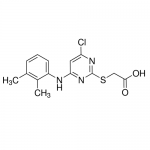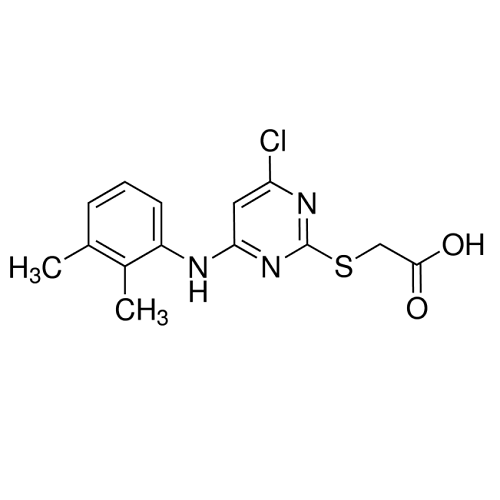| Product Name | WY-14643 |
| Description |
PPAR alpha agonist |
| Purity | 98.5% (HPLC); NMR (Conforms); MS (Conforms) |
| CAS No. | 50892-23-4 |
| Molecular Formula | C14H14ClN3O2S |
| Molecular Weight | 323.8 |
| Field of Use | Not for use in humans. Not for use in diagnostics or therapeutics. For in vitro research use only. |
Properties
| Storage Temperature | -20ºC |
| Shipping Temperature | Shipped Ambient |
| Product Type | Agonist |
| Solubility | Soluble in DMSO (40 mg/ml) |
| Source | Synthetic |
| Appearance | Off white powder |
| SMILES | Cc1cccc(c1C)Nc2cc(nc(n2)SCC(=O)O)Cl |
| InChI | InChI=1S/C14H14ClN3O2S/c1-8-4-3-5-10(9(8)2)16-12-6-11(15)17-14(18-12)21-7-13(19)20/h3-6H,7H2,1-2H3,(H,19,20)(H,16,17,18) |
| InChIKey | SZRPDCCEHVWOJX-UHFFFAOYSA-N |
| Safety Phrases |
Classification: D2B Toxic Material Causing Other Toxic Effects Moderate skin irritant - Moderate respiratory irritant, Moderate eye irritant Hazard statement(s): H302 Harmful if swallowed. H315 Causes skin irritation. H319 Causes serious eye irritation. H335 May cause respiratory irritation. H350 May cause cancer. Precautionary statement(s): P201 Obtain special instructions before use. P261 Avoid breathing dust/ fume/ gas/ mist/ vapours/ spray. P305 + P351 + P338 IF IN EYES: Rinse cautiously with water for several minutes. Remove contact lenses, if present and easy to do. Continue rinsing. P308 + P313 IF exposed or concerned: Get medical advice/ attention. |
| Cite This Product | WY-14643 (StressMarq Biosciences Inc., Victoria BC CANADA, Catalog # SIH-531) |
Biological Description
| Alternative Names | 4-Chloro-6-(2,3-xylidino)-2-pyrimidinylthioacetic acid, Pirinixic acid, 2-[4-chloro-6-[(2,3-dimethylphenyl)amino]pyrimidin-2-yl]sulfanylacetic acid, WY-14,643, WY14643, WY 14643, Wyeth 14,643 |
| Research Areas | Cancer, Cancer Carbohydrate Metabolism, Cancer Lipid and Lipoprotein Metabolism, Cancer Metabolism |
| PubChem ID | 5694 |
| Scientific Background | WY-14643 is a selective agonist of peroxisome proliferator-activated receptor alpha (PPARα), primarily studied in the context of lipid metabolism and inflammation. Although not widely cited in neurodegenerative disease research, its anti-inflammatory properties and ability to modulate oxidative stress pathways suggest potential relevance in neuroinflammation and neurodegeneration. WY-14643 may be explored for its capacity to regulate metabolic dysfunction and glial activation in neurological disorders. |



Reviews
There are no reviews yet.